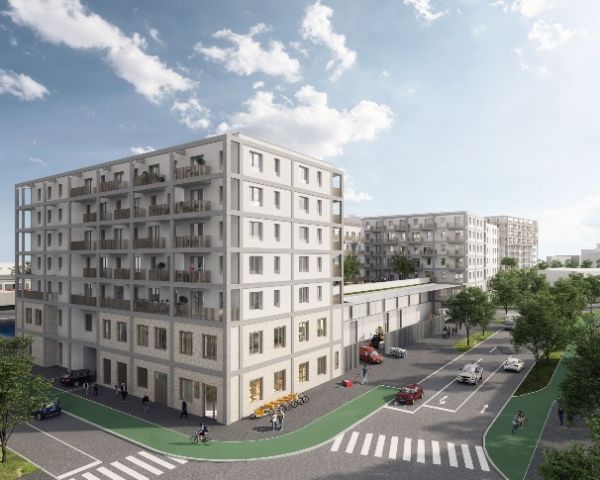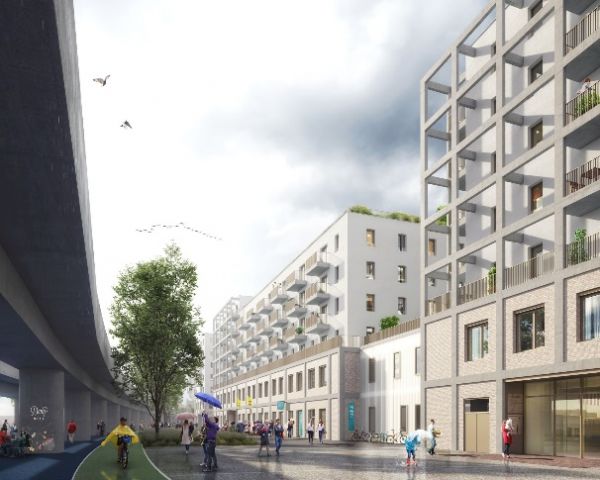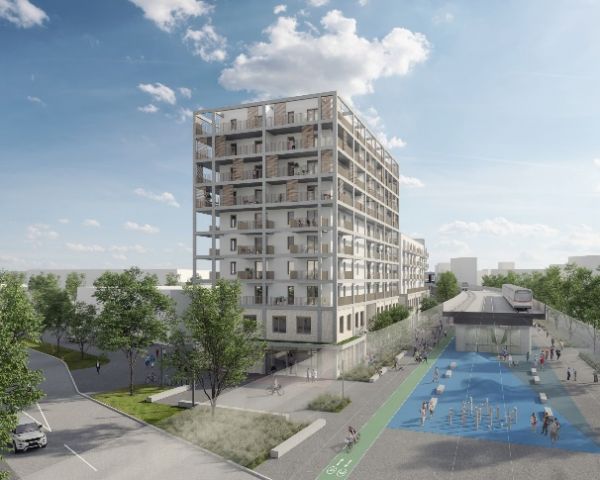GreenDeal4Real - Improving the thermal comfort in mixed-use areas through cost-effective green infrastructure
Short Description
Greening measures are effective and sustainable possibilities to cool urban areas, achieve energy savings and consequently reduce CO2 emissions. Together with a public awareness of positive effects of greening measures with regards to climate change (e.g., soil protection, reduction of urban heat island effect, rainwater management), rising interests from affected cities, authorities and players of the real estate market can be observed. To transfer green solutions into reality, empirical studies, and scientific research about quantification of positive effects and optimization of planning processes are required. The project GreenDeal4Real aimed to contribute knowledge with scientific support, documentation, and evaluation of a specific real estate project in Vienna to implement greening measures in early planning stages of real estate development. It further investigated which information is required in the individual planning stages to optimize greening and improve local microclimate.
The real estate development company 6B47 was planning a mixed used building complex with commercial, and office spaces together with 800 residential appartements in the 22nd district of Vienna. GreenDeal4Real focused on the improvement of thermal comfort in the area by exploring effects of different greening measures in microclimate simulations. The specificity of the building project was the superordinate usage as "commercial mixed-use area", determined in the technical conception "productive city" of Vienna. The consortium of the project GreenDeal4Real aims to develop solutions, providing practical and scientifically sound supporting information, guidelines and data for public authorities and real estate developers to consider microclimatic effects of building projects already in early planning stages. All stakeholders are expected to join forces to minimize negative impacts of additional soil sealing by increasing the share and well thought-through positioning of vegetation in the development area.
The research project is not only focusing on technical innovations and novel façade greening methods, but especially on innovations addressing the process, organization, and policy frameworks (e.g., urban development contracts). The systemic and integrative approach is reflected in the composition of the consortium with real estate developers, landscape planners, landscape architects, innovation lab, greening company, and research institution.
The overarching objective of the research project was the simulation and demonstration of innovative greening solutions in the mixed use residential and commercial area Aspernstraße/Lavaterstraße. In detail, the following goals were pursued:
- Evaluation of selected greening measures under present and future climate conditions
- Integration of greening options in the early planning process
- Integration of all relevant players and stakeholders
- Development of transferable recommendations
From a methodological point of view, basic considerations of efficient implementation of urban greening possibilities were evaluated in the first phase. The initial planning state and several greening options were simulated with state-of-the-art microclimate models (Ladybug-Tools & ENVI-Met). Based on the results, different extension levels of façade and roof greening were assessed and one selected planning concept under future climate conditions simulated and evaluated. In parallel, a planning lab developed current and transferable requirements and recommendations for climate adapted planning of commercial and residential mixed-used areas. In expert interviews with local administrative authorities of the city of Vienna, legal circumstances and potential policy changes were analyzed. The results were documented and summarized in a catalogue of requirements and criteria for roof and façade greenings.
Project deliverables and results includes status quo analysis and mapping of hot spots in the development area, a report of greening options and their effects, economical assessment of identified greening options, a report of microclimate analyses (greening scenarios, present and future climate conditions), a catalogue of requirements and criteria for roof and façade greening, a factsheet how to implement greening measures in early planning stages of real estate development projects, numerous specialist presentations and two scientific publications (Schneider et al. 2023, Tötzer et al. 2023).
Supporting a real estate development project through a scientific project already from early planning stages leads to essential new findings and insights. It provides the possibility to intervene in core aspects of the building construction and build decisions on scientifically sound results (e.g., microclimate simulations). However, as a pioneer project, it entails the risk of delays in issuing the final building permit and start of construction. Due to changing framework conditions from authorities, a project extension was proposed and approved in July 2022. During this time, the justified hope to carry out the research project with the suggested delays existed. Nevertheless, it was decided and communicated in May 2023, that the presented draft does not receive the required permit and authorization.
Following the consequences, the research project GreenDeal4Real was prematurely terminated by September 30th, 2023. The results are therefore focused on the planning phase. All aspects and planned activities related to implementation and monitoring were not executed anymore.
Nevertheless, the project led to important results and new findings for each project partner. Based on these, greening measures can be integrated, supported and fostered already in early planning station of real estate development projects.
Methods
The project develops solutions that offer practical and at the same time scientifically sound assistance to the City of Vienna and real estate developers. For each stage - from planning to actual construction - it will be assessed how to take microclimatic effects into account and how to optimally compensate for the negative effects of additional sealing through greening measures.
The research project is not only dedicated to technological innovations with innovative façade greening approaches, but also to innovation questions that address the process, the organisation and the framework conditions (e.g. urban development contract).
Thus a systemic, integrative approach is pursued, which is also reflected in the composition of the consortium (developer, landscape planner, landscape architects, innovation laboratory, research institution, greening company).
For assessing the effects quantitively, the implemented (greening) measures are evaluated in a two-year monitoring (energy and comfort monitoring, monitoring of the microclimate, cost monitoring, socio-scientific monitoring).
Expected results
GreenDeal4Real is intended to create a best-practice demo example of mixed use areas sensitive to climate change. The project results will be summarised in guidelines that ensure a high transferability to other areas and support practitioners such as real estate developers, planners or city administration in realising and facilitating climate-sensitive construction projects from strategy to actual implementation.
Project Partners
Project management
AIT Austrian Institute of Technology GmbH
Project or cooperation partners
- 6B47 Real Estate Investors AG
- grünplan gmbh
- Lindle+Bukor
- MA 18 - Stadtentwicklung und Stadtplanung
- 90deGreen GmbH
- GRÜNSTATTGRAU
Contact Address
DI Dr. Tanja Tötzer
AIT Austrian Institute of Technology GmbH
Giefinggasse 4
A-1210 Wien
Tel.: +43 (505) 50-4548
Mobile: +43 (664) 825 10 02
E-mail: tanja.toetzer@ait.ac.at
Web: www.ait.ac.at/city



